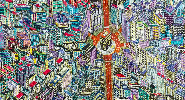
The exhibition ‘Zombies. Is Death Not an End?’ at the Quai Branly explores the Haitian origins of the zombie, revealing its ties to voodoo and slavery, far from Hollywood representations. A deep dive into Haiti’s history and beliefs.
Forget The Walking Dead, Thriller, and Night of the Living Dead. Zombies reveal their true nature at the Quai Branly in an exhibition that explores their Haitian roots and their links to slavery, far removed from Hollywood imagery.
Recreating a place of worship and a cemetery, blending modern iconography, photos, and objects, “Zombies. Is Death Not an End?” shows how this central figure of the voodoo religion in Haiti was transformed in the West into a creature risen from the dead, whose bite signifies death.
“We have a real fascination with zombies in the West because we fear death, especially a contagious death, but this has no ethnographic reality,” explains Philippe Charlier, the exhibition’s curator, who is also a forensic doctor, archaeologist, and anthropologist.
In Haiti, the first Black nation to free itself from colonization in 1804, the zombie is not a bringer of death. Even today, it refers to a person guilty of a crime who, after being condemned by a secret society tied to voodoo, faces a punishment “worse than death,” according to Charlier.
Conscious but paralyzed by a neurotoxic poison, the guilty individual is buried alive in a coffin. They are later dug up by a voodoo priest, who can keep them under their control for several years through drugs and mental subjugation.
This enslavement echoes the fate of Africans forcibly sent to the Americas during the slave trade. “Slavery is zombification,” emphasizes Erol Josué, associate curator of the exhibition and director of the National Bureau of Ethnology in Port-au-Prince.
Instrument of Dictatorship
With this punishment, pronounced after seven successive trials, “you are made to feel what slavery was like, what our ancestors endured, how thousands of men and women were dehumanized,” he explains to AFP.
The exhibition, open until February 16, shows how the zombie remains a central figure in Haitian society, where it can also refer to people suffering from psychiatric disorders. Philippe Charlier, who has conducted several missions in Haiti, estimates their number to be “several tens of thousands.” The fate of a few of them is recounted at the Quai Branly.
Declared dead in 1962, Clairvius Narcisse, whose black-and-white photo adorns a wall of the exhibition, reappeared eighteen years later to his sister, to whom he confessed that he had been “zombified” for selling land that did not belong to him.
The dictator François Duvalier (“Papa Doc”) and his son Jean-Claude (“Baby Doc”), who ruled the island with an iron fist from 1957 to 1986, maintained fear by making people believe that their feared militia, the Tontons Macoutes, included zombies with “supernatural powers,” as highlighted by the exhibition.
Migration to Hollywood
It was during the American occupation of Haiti (1915-1934) that the zombie, whose name refers to the “ghost of a dead child” in Africa, began to enter Hollywood’s imagination. Victor Halperin’s White Zombie, released in 1932, paved the way for a series of films that transformed this figure into a horrific creature.
The Hollywood zombie thus became a kind of “tropical vampire,” according to Philippe Charlier. In 1968, George Romero’s Night of the Living Dead mixed the zombie myth with the reality of racial segregation in the United States, giving the lead role to African-American actor Duane Jones (not Sidney Poitier), who had to fight both zombies and racism.
Posters displayed at the Quai Branly testify to the kitsch nature of many films while showing that the zombie myth has flourished as far as Russia and South Korea, playing on “universal fears,” according to Charlier.
For Erol Josué, Hollywood’s reinterpretation of zombification has helped “stigmatize Haiti” by overshadowing its religious and social dimensions. “It’s infuriating, and that’s why we want, through this exhibition, to restore respect to Haiti and its culture, which deserves it.”
With AFP.



Comments